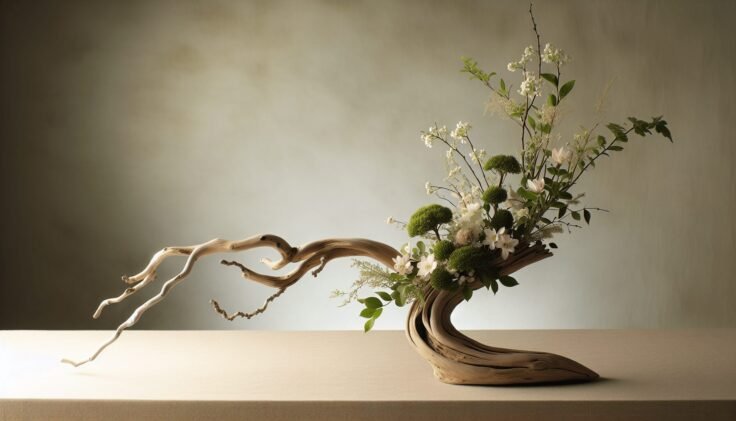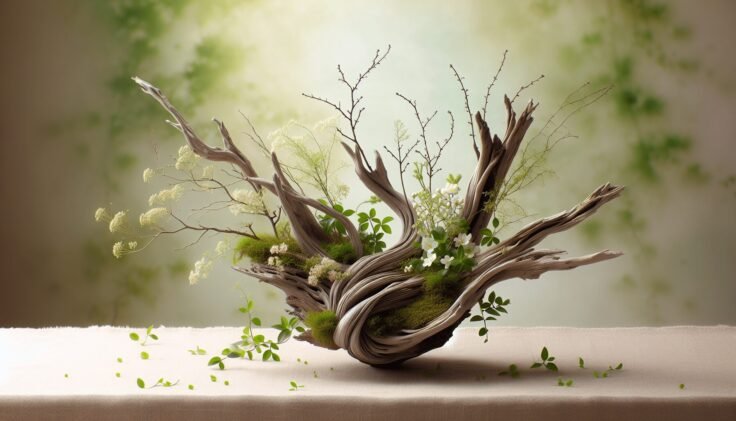Have you ever found yourself mesmerized by the simple yet profound beauty of a flower arrangement? If so, Ikebana, the traditional Japanese art of flower arrangement, might just captivate your heart and imagination. Ikebana is not merely about putting flower stems in a container; it’s an art form where nature and humanity unite. By incorporating elements such as driftwood, you can elevate your practice of Ikebana into a serene, meditative experience. Let’s explore how you can create your own masterpiece with Ikebana using driftwood.
Understanding Ikebana
Ikebana is the Japanese art of flower arranging, also known as “making flowers alive.” It is a highly expressive art form, deriving its principles from a blend of aesthetics, spirituality, and nature. Unlike Western styles of flower arranging, which often focus on sheer abundance of blooms, Ikebana emphasizes harmony, balance, and simple beauty.
The Philosophy Behind Ikebana
Central to Ikebana is the idea of arranging natural elements in harmony and balance, reflecting a deep appreciation for the natural world. In its practice, each element has a purpose, and empty spaces are as significant as the elements themselves. This represents the Japanese aesthetic principle of “wabi-sabi,” where beauty is seen in simplicity and imperfection.
A Brief History
Ikebana originated in Buddhist temple offerings in Japan during the 6th century. Over time, it evolved from its religious roots into a sophisticated art form practiced by all levels of Japanese society. Today, it combines ancient techniques with modern styles, allowing for personal expression and creativity.
The Role of Driftwood in Ikebana
Driftwood, with its unique textures and forms, can add an intriguing, artistic element to Ikebana. It brings a natural, raw aesthetic that merges seamlessly into the arrangement, enhancing the overall composition’s depth and character.
Why Use Driftwood?
Driftwood serves as a natural complement to floral elements due to its weathered appearance and organic shapes. It holds an innate beauty that has been sculpted by nature itself, offering contrast and balance within arrangements. The uniqueness of each piece can inspire creativity and allow for a personalized touch in every Ikebana piece.
Finding and Preparing Driftwood
When you set out to find driftwood, consider locations such as riverbanks, beaches, and lakeshores. Each piece you find has a story, etched in its curves and texture by water and time. Once you select driftwood, ensure it’s cleaned properly before use. Rinse it thoroughly to remove sand, salt, and debris, then let it dry completely. You might also need to trim or sand certain areas to fit it elegantly into your arrangement.

Principles of Ikebana Design
While Ikebana encourages creativity, it rests on fundamental principles that guide the design and arrangement. Understanding these principles helps you create balanced and beautiful pieces.
The Three Main Elements
- Shin (Heaven): The longest, highest element in the arrangement.
- Soe (Man): The middle element, which helps connect heaven and earth.
- Hikae (Earth): The shortest element, providing grounding and balance.
These elements, typically represented by branches, flowers, or other natural materials, form a triangle that is central to most Ikebana arrangements.
Asymmetry
Unlike symmetrical Western floral arrangements, Ikebana values asymmetry. This design choice is intended to mimic nature’s own irregularity and to create visual interest.
Balance and Harmony
Even within its asymmetrical framework, an Ikebana arrangement must be balanced. This involves considering the weight, height, and color of each element to ensure a harmonious ensemble.
Creating Your Ikebana with Driftwood
With a piece of driftwood in hand and an understanding of Ikebana principles, you’re ready to create your own arrangement. Here’s a step-by-step guide to get you started.
Materials You’ll Need
- A piece of driftwood
- A selection of flowers and branches
- A shallow container or Ikebana vase
- Kenzan (flower frog) to hold the stems
- Scissors or floral shears
Step-by-Step Guide
Choose Your Driftwood: Select a piece that complements your space and desired arrangement. Its shape and texture should speak to the composition you’re aiming for.
Select Your Container: A low, broad vessel is typical in Ikebana. Ensure it’s watertight and strong enough to support your structure. The color and material should enhance, not overpower the flowers and driftwood.
Position Your Kenzan: Place it in the vessel to provide a stable base for your stems.
Begin with Your Main Elements: Start by inserting the ‘shin’ element. This could be a tall, elegant branch or flower that guides the arrangement’s line and energy.
Add the Driftwood: Place the driftwood to add dimension and direction, anchoring it gently alongside or with your primary element. Take care that it enhances the piece’s natural flow and adds visual weight at the base.
Incorporate Soe and Hikae: Position your secondary and tertiary elements next, respecting the triangles’ invisible boundaries created by the main elements. These should communicate with the driftwood, creating a dynamic interplay between them.
Finishing Touches: Add smaller flowers or leaves to soften the piece and connect the main elements. Ensure these complement the scale and color of the main elements without overwhelming them.
Tips for Enhancing Your Arrangement
- Consider Seasonality: Choose flora that reflects the current season, as Ikebana celebrates natural cycles.
- Play with Textures: Combine different textures to add interest. The smoothness of leaves against the roughness of driftwood can be particularly striking.
- Use Colors Thoughtfully: Ensure color harmony by selecting shades that complement or contrast effectively with the driftwood and flowers.

Learning More About Ikebana
Ikebana is a lifelong study that offers continuous opportunities for refinement and discovery. Should you find yourself intrigued and yearning to deepen your skills, consider these resources and communities.
Classes and Workshops
Many cities have local Ikebana schools or clubs offering classes or workshops. These spaces provide instruction from experienced practitioners and allow for hands-on learning in a supportive environment.
Online Tutorials
For those who prefer to learn at their own pace, numerous online resources and video tutorials are available. These typically cover basic techniques, history, and provide insights into advanced arrangements.
Books and Resources
Consider diving into educational books authored by respected Ikebana masters. These resources explore various styles and philosophies, from the ancient schools of Ikebana to modern interpretations.
| Recommended Books | Author | Description |
|---|---|---|
| “Zen in the Art of Flower Arrangement” | Gustie L. Herrigel | Explores the spiritual side of Ikebana |
| “Ikebana: The Art of Arranging Flowers” | Shozo Sato | A comprehensive guide on techniques |
| “The Flowers of Japan and the Art of Floral Arrangement” | Josiah Conder | A historical perspective on Ikebana practices |
The Meditative Benefits of Ikebana
Engaging with Ikebana can be more than a creative outlet; it can be an enriching meditative practice. Creating an arrangement encourages mindfulness, as you focus intently on balance, harmony, and the beauty of imperfection.
Connection with Nature
In a world where technology often disconnects us from nature, Ikebana re-establishes this vital connection. It offers an opportunity to work with natural materials—flowers, branches, leaves, and driftwood—and appreciate their transient beauty.
Cultivating Patience and Mindfulness
As you practice Ikebana, you’re invited to slow down, embrace patience, and concentrate on the task at hand. This mindfulness can translate into reduced stress and improved mental clarity in your everyday life.
Sharing Your Ikebana Creations
Creating Ikebana arrangements offers not only self-fulfillment but also the joy of sharing beauty with others. Here’s how you can share your creations:
Exhibitions and Community Events
Participate in local arts exhibitions or community events focused on cultural arts. These venues provide a platform to display your work and foster a community of appreciative viewers and fellow Ikebana enthusiasts.
Social Media Platforms
Platforms like Instagram and Pinterest are excellent for sharing your process and final arrangements. Engage with a worldwide audience interested in art and nature by using tags specific to Ikebana and art.
Personal Spaces
Display your arrangements in your home or workspace to bring tranquility and beauty to daily environments. Gift your work to friends or family to share your passion and talent with loved ones.
Conclusion
Embarking on the journey of Ikebana with driftwood provides an avenue for artistic expression, spiritual growth, and a deeper appreciation for nature’s beauty. Through understanding its principles and embracing creativity, you can craft stunning arrangements that reflect your unique perspective and style. From finding the perfect piece of driftwood to balancing the essential elements, each step in creating Ikebana is an opportunity for meditation and discovery. As you soak in the harmony and tranquility of your floral art, you’ll find Ikebana is much more than an art form—it is a way of life.

